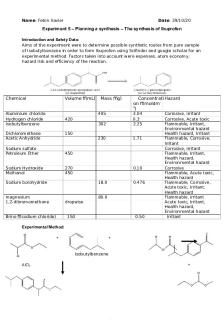Title The Synthesis of Alum PDF

| Title | Title The Synthesis of Alum |
|---|---|
| Course | Principles of Chemistry I Laboratory |
| Institution | Utah Valley University |
| Pages | 2 |
| File Size | 71.1 KB |
| File Type | |
| Total Downloads | 3 |
| Total Views | 145 |
Summary
Examples of how to do lab writeups....
Description
Title: The Synthesis of Alum We synthesized an alum, potassium aluminum sulfate dodecahydrate and calculated the yield of the experiment. We created the alum by converting 1.0041 grams Aluminum from neutral to a +3 ion within a reaction with 25mL of KOH solution; we observed that this reaction released gas. After vacuum filtration we observed the solution was very clear. We then added 35 mL which made the reaction appear white and fluffy. The final product we found became clear again as we heated the solution until all solids were dissolved. We then placed the solution in an ice bath to allow the solution to form crystals. After about 30 minutes we found very small, sugar-like crystals. We then filtered the crystals with ethanol and allowed them to dry for as long as possible in a warming drawer to try to get rid of any leftover liquid. We then calculated the yield of the experiment and analyzed the data. We first calculated the theoretical yield of the alum by converting the amount of Aluminum we had (1.0041 grams) to moles and then multiplying that value (0.0335 mole) by the molar mass of the aluminum alum which was 474.3652 to find the theoretical value: 15.8912. We then used the percent yield equation: actual/theoretical (15.5650g/15.8912g) to find our percent yield: 97.94%. Our percent yield was affected by how much of each substance was totally converted within each of the steps of the experiment; one of the factors that affected our percent yield greatly that we had little control over was how much water was stored within the crystals. Because our crystals were very small, and possibly still wet, they clung to the glass stirring rod, it was harder to be sure that leftover water was not still within them. The equations of each portion of the experiment furthered evidence that we created the correct alum as they correlated with our observations: 1. ()
a. Gas was produced2. + a. As we added we noticed a white and fluffy quality (a precipitate formed, ) 3. 4. a. Final product- crystals emerged
Alum is meant to dissolve. Because of the way we synthesized the alum, some alum had to be left in the solution so our percent yield was close to 100% but not quite. We learned about the solubility of alum within this lab along with many other things; we used an ice bath to form the crystals because the alum is less soluble in colder temperatures and vice versa. By synthesizing and analyzing the percent yield of an alum we are now better able to understand the synthesis process: you have to select certain reactants to end with certain products and how to find the percent yield within an experiment....
Similar Free PDFs

Title The Synthesis of Alum
- 2 Pages

Exp. 15 Synthesis of Alum S20
- 10 Pages

Tpp synthesis - SEE TITLE
- 16 Pages

The synthesis of Ibuprofen
- 4 Pages

EXp= Potash alum
- 4 Pages

Title : The Expressionist Utopia
- 4 Pages

Indefeasibility of title
- 7 Pages

Title: PROPERTIES OF FLUID
- 11 Pages

Retention OF Title
- 4 Pages
Popular Institutions
- Tinajero National High School - Annex
- Politeknik Caltex Riau
- Yokohama City University
- SGT University
- University of Al-Qadisiyah
- Divine Word College of Vigan
- Techniek College Rotterdam
- Universidade de Santiago
- Universiti Teknologi MARA Cawangan Johor Kampus Pasir Gudang
- Poltekkes Kemenkes Yogyakarta
- Baguio City National High School
- Colegio san marcos
- preparatoria uno
- Centro de Bachillerato Tecnológico Industrial y de Servicios No. 107
- Dalian Maritime University
- Quang Trung Secondary School
- Colegio Tecnológico en Informática
- Corporación Regional de Educación Superior
- Grupo CEDVA
- Dar Al Uloom University
- Centro de Estudios Preuniversitarios de la Universidad Nacional de Ingeniería
- 上智大学
- Aakash International School, Nuna Majara
- San Felipe Neri Catholic School
- Kang Chiao International School - New Taipei City
- Misamis Occidental National High School
- Institución Educativa Escuela Normal Juan Ladrilleros
- Kolehiyo ng Pantukan
- Batanes State College
- Instituto Continental
- Sekolah Menengah Kejuruan Kesehatan Kaltara (Tarakan)
- Colegio de La Inmaculada Concepcion - Cebu






